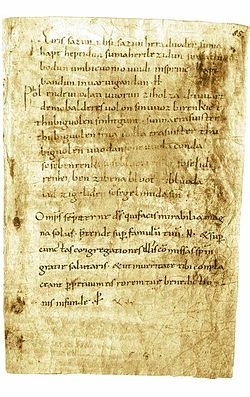Merseburg charms

The Merseburg Incantations (German: die Merseburger Zaubersprüche) are two medieval magic formulae or incantations, written in Old High German. The incantations are the only known example of Germanic paganism written in this language. They were rediscovered in 1841 by Georg Waitz, who found them hidden inside of a theological scripture from Fulda which was written in the 9th or the 10th century. However the time period the incantations themselves were composed remains speculative. The scripture was stored in the library of the cathedral chapter of Merseburg – hence their name.
Form
Both incantations are binomial. Its magic formulae follows an epic-telling prologue, that portrays a former event, in the form of an analogy magic (just like it was before... also now shall it be so...). In the form of its verses, the spells represent a transition work - the verses partly show alliteration, partly the end-rhyme, like poems in the Christian era of the 9th century it was written down.
History
Among the early Germanic tribes, incantations were used, which were believed to give the power people wanted through specifically arranged words (Simek, 1995). Incantations in the Germanic languages area are passed on in large number. However, all these come from the Middle ages and are therefore embossed by Christian influences. What is unique about the Merseburg Incantations is its seemingly pagan origin, which suggests it was composed before the Christian era (750 n. Chr.), therefore it shows the pagan religiosity in its purer form. They came in the 10th century from the library of a well-read cleric who supposedly belonged to the Fulda monastery, on a remaining portion of a registered liturgical book for which purpose is unknown. So the incantations became available for us in Carolingian minuscule on the flyleaf of the Latin sacramentary.
The incantations became famous in the modern time through the evaluation of the Grimm brothers who wrote the following:
- Lain Jena near Leipzig, the extensive library of the Domkapitels was often visited by Merseburg scholars and been used. All passed a codex while taking only well-known church scriptures in detail. Now however, after its whole content is examined, a jewel is found, which reminds most famous libraries don't have anything to put down aside...
The incantations then were published later in the edition About two discovered poems from the time of the German Heldenthums (1842) by the Grimm brothers and now are stored in the Merseburg Domstifts Library.
Incantation 1 - liberation of prisoners
The first spell is a "Lösesegen" type. It describes a number of "Idisen" (Valkyrie women) being told to free warriors caught during the battle from their shackles. The last two lines puts the magic words "Leap forth from the fetters, escape from the foes" that should redeem the warriors.
|
Eiris sazun idisi |
Once the Idisi set forth, |
Incantation 2 - horse cure
Balder (also known as Phol) is with Odin when Balder's horse dislocates its foot while riding through the forest (holza). Odin is saying as a result: "Bone to bone, blood to blood, limb to limb, like they were glued". The depictions from the 5th-6th century show Odin healing a horse. Unfortunately, the other Gods' name cannot be identified unequivocally. Only clear names are "Uuôdan" (Wodan, Wotan, Odin) and. "Frîia" (Freya, his spouse). With the other names, it is not even sure whether they really are names of Gods since different interpretations of their translation are available.
|
Phol ende uuodan sose benrenki, |
Phol and Odin Bone-sprain, |
Explanations
- Idisen: Possibly identical with the Dísir, female deities from the Norse mythology, probably used for both Norns and Valkyries, the ones that decide who should fall on the battlefield.
- Balder: the God of the light in the northern mythology.
- Uuôdan: the Old High German form of Odin.
- Sunna: may refer to the goddess Sol.
Adaptations
Many german rock groups and musicians were inspired by the Merseburg Incantations and brought out their own version. The already "classic" adaptation of the first incantation comes from the group Ougenweide; it is a free invention and on no real tradition based. The group In Extremo, whose song Küss mich (Kiss me) was in the 2003 charts, brought the first incantation in their album Verehrt und angespien in 1999 and published the second incantation in their album Sünder ohne Zügel (Sinners without reins) in 2001. In the same year, they did it also with the project Helium Vola in a quite different context. The band Corvus Corax has these incantations on the album Ante Casu Peccati, having made it into a song. Another adaptation was featured by Tanzwut, a musical project of Corvus Corax, in the album of the same title. Another band is Nagelfar whose die Sprüche auf Virus West has the incantations included. None of these reinterpretations is based on the medieval melodies.
Currently
The Merseburg Incantations was recently (until 14. November 2004; extend until 30. November 2004) in the framework of the exhibition "Inter cathedral and world - 1000 years of Domkapitel Merseburg", to be shown in the cathedral in Merseburg. They were shown after the last exhibition 1939 to be admired for the last time in this year. Now, they vanished again behind safe doors.
References
- Rudolf Simek: Lexikon der germanischen Mythologie. 2nd Edition 1995. ISBN 3520368021
- The English translation of the incantations by D. L. Ashliman at his website. [1]
